Syn.: Pinus insularis Endl., Pinus khasyana Griff., Pinus langbianensis A. Chev., Pinus kesiya var. langbianensis (A. Chev.) Gaussen ex N.-S. Bui, Pinus kesiya subsp. insularis (Endl). D. Z. Li
Family: Pinaceae Lindl.
Higher classification: genus Pinus L., subgenus Pinus, section Pinus, subsection Insulares E. Murray
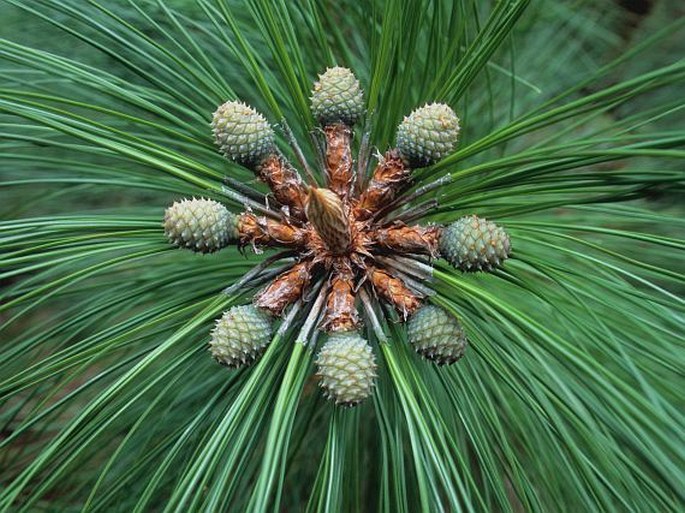
Distribution: This species occupies the most extensive native geographic range of distribution among Asian tropical pines. It comprises several distant areas with extensive abundant occurrences, among which there are small groups of isolated occurrences or areas of sparse distribution. Most of the distribution area lies in the tropical region with the most extensive particular area in the center of the mainland distribution around 21° N in central Myanmar and across the border in N Thailand. The northern distribution limit is at 27° N in NW Myanmar in the Patkai Hills and in the neighbouring Naga Hills on both sides of the border with India. The isolated northwestern area is found in the Khasi Hills in Meghalaya (India) from which it was described for the first time. Another from larger particular areas is situated in the Chin Hills in central Myanmar west of Irrawaddy between 20° and 23° N. Small areas of occurrences in northeastern Myanmar also marginally overlap to Chinese Province of Yunnan, where this species hybridize with closely related Pinus yunnanensis. The native mainland distribution east from 100° E across Thailand and Laos to central Vietnam is only scattered and represented by rather small local occurrences. The last, more extensive mainland particular area lies in the Dalat Highlands (also known as the Langbian Plateau) in southern Vietnam, which represents the southern limit of the species’ distribution around 12° N. More than 1200 km to the northeast across the South China Sea the separate distribution area of this species is found in the northern part of the Luzon Island in the Philippines (mainly in the Cordillera Central and also in the Zambales Mountains), from which it was described as Pinus insularis.

Ecology: Khasi Pine occurs on open rounded mountain ridges and mild slopes or on undulating upland plateaus, in mountain ranges with hilly topography, only exceptionally exceeding 3000 m, in a range of (300–)800–2200(–2900) m (hence in altitudes corresponding to mostly subtropical climate), usually on clayey, not too rocky grounds. In the main areas of distribution and in the usual elevation range it typically forms extensive pure forests. This species is well adapted to forest fires which occasionally occur in its growths. In occasional mixed forests in the mainland is associated with broadleaved tree species of Quercus, Castanopsis, Schima or Dipterocarpus and also conifers as Pinus latteri, Keteleeria evelyniana or Fokienia hodginsii, from low trees or shrubs often with members of Ericaceae; on the Luzon Island with Quercus jordanae, Q. soleriana, Turpinia ovalifolia, Eugenia santosii, Eurya buxifolia, E. coriacea, Podocarpus javanicus, Rapanea philippinensis and Symplocos luzonensis.
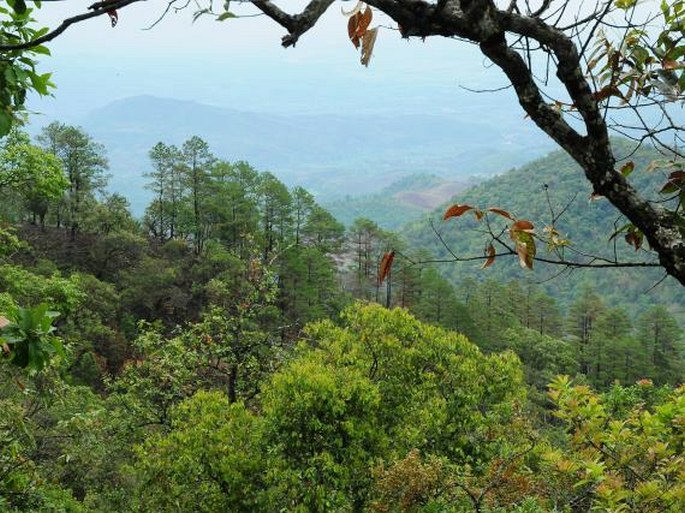
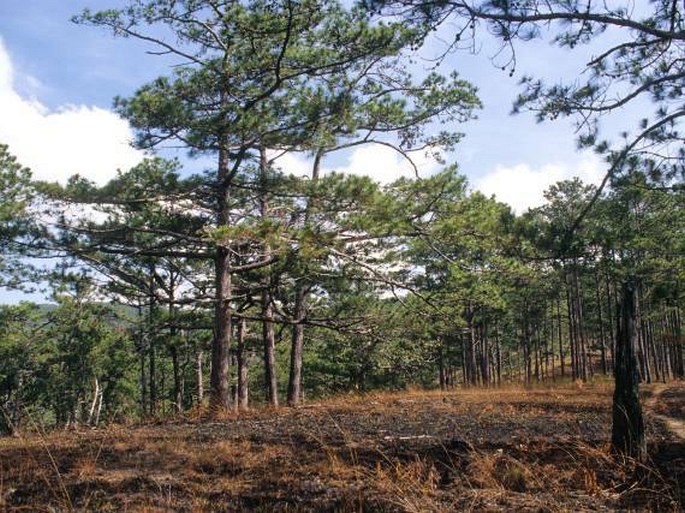
Description: Tree to 35–45 m tall with trunk to 1 m in diameter, free of branches up to 20 m in old trees; bark redish-brown or dull gray, thick, reticulately fissured, breaking off in small thick irregular plates; crown relatively sparse, conical in young trees, becoming rounded and umbrella-shaped when older; main branches of older trees spreading; branchlets relatively thick with foliage shedding in second year. Fertile shoots typically seronodal (formed by two segments arising during spring and summer growth), usually pale brown when mature. Needlelike leaves in fascicles of 3 (very rarely of 2 or 4) with persistent, initially ca. 14–18 mm long sheath, soft, slender and flexible, spreading to arcuate, (11–)15–24(–27) cm long and (0.6–)0.8–1.3(–1.5) mm wide, with acute apex and minutely serrate edges, bright green, resin ducts 2–5(–9), all marginal or combined with one median near the ventral edge. Male strobili yellow or light brown, 2–3 cm long and ca. 0.5 cm wide. Ovulate strobili (conelets) solitary, in pairs or 3–8-merous whorls, about 10 mm long, on usually somewhat longer peduncle, greenish-purple. Seed cones spreading or more often reflexed on thick and firm, ca. 0.5–1 cm long peduncle, (4.5–)5.5–9.5(–12) cm long and 3–4.5 cm wide when closed or 5–8 cm wide when fully open; after seed dispersal firmly persisting for many years; seed scales woody and very firm; apophyses usually thick, broadly (or roundly) pyramidal to flat with the distal edge rounded or broadly cuneate and with rather distinct transverse keel, umbo mostly distally shifted with minute, backward directed or upright mucro. Seeds including the wing ca. 15–28 mm long; seed corpus (4.5–)5.0–6.5(–7.5) mm long; wing effective, generally oblique, ca. 10–20 mm long.
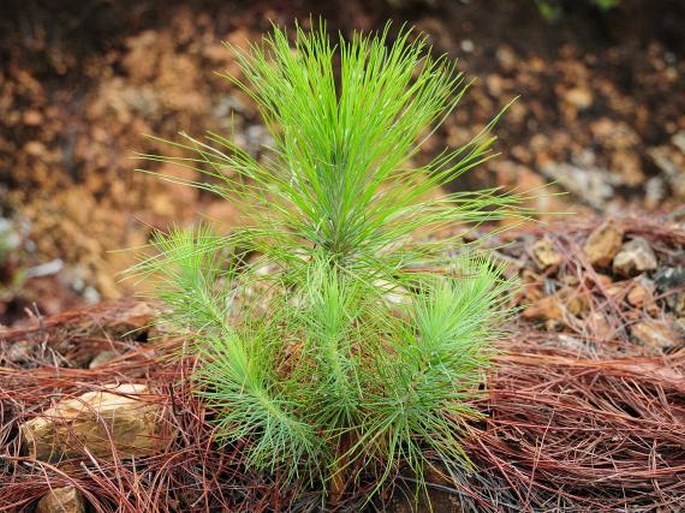
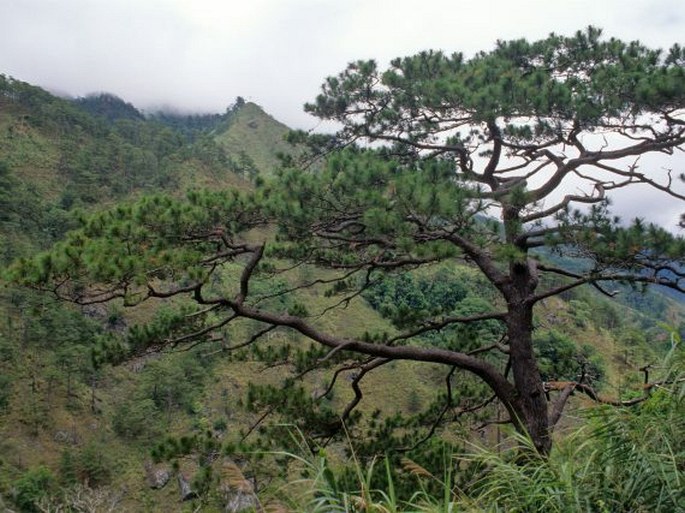
Taxonomic notes: Pinus kesiya was variously classified within last two centuries due to the lack of critical morphological and taxonomic comparison of populations from different particular areas of its distribution. In the most usual old classification concept two species were distinguished, the continental with using various variants of latinized epithets derived from the Khasi Hills (such as kasya, kesiya, khasia, khasya, khasyana), and the insular from Philippinese Luzon under the name Pinus insularis. This concept became complicated in 1944 by description of a similar separate species Pinus langbianensis from the Dalat Highlands in southern Vietnam. Several nomenclatural combinations of these three taxa, including the fourth similar Pinus yunnanensis, reflecting various taxonomic concepts, had been made during the second half of the 20th century. Around the turn of 20th and 21th century, the most accepted concept differentiated Pinus kesiya and P. yunnanensis separately and the former with two subspecies, the mainland and the insular (D. Z. Li in Eding. J. Bot, 54, p. 346, 1997), or two varieties, the autonymic mainly from the western part of its distribution and var. langbianensis mainly from southern Vietnam (A. Farjon: World Checklist and Bibliography of Conifers, ed. 2, 2001). However, the cited author mentioned both varieties without its clearly defined geographic distribution and also their morphological differentiation in his later publications (A. Farjon: Pines, drawings and descriptions of the genus Pinus, ed. 2, 2005; A handbook of the world’s conifers, 2010) is rather vague. Similarly, all morphological differences ascribed to the three taxa with epithets kesiya, insularis and langbianensis by previous authors do not reflect the variation and situation in nature. Recently, two revisions of the Pinus kesiya complex were published (R. Businský in Harvard Pap. Bot. 13, 1–28, 2008; R. Businský et al. in Pl. Syst. Evol. 300, 273–285, 2014) based on morphological comparison and statistical evaluation of samples from all four main particular areas of Pinus kesiya together with all related taxa. These studies demonstrated absence of differentiation between the corresponding populations with taxonomic conclusion that none infraspecific taxon (subspecies or variety) within Pinus kesiya is justified. The concept of Pinus kesiya as one species without infraspecific taxa is also accepted in Flora of China (4, 1999).
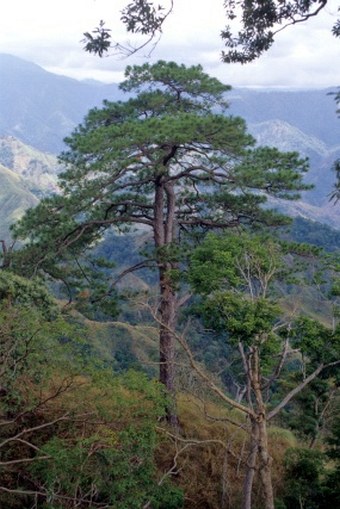
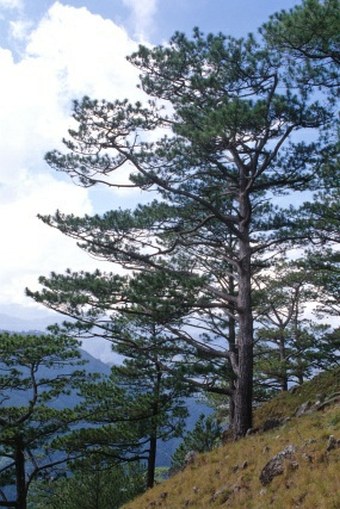
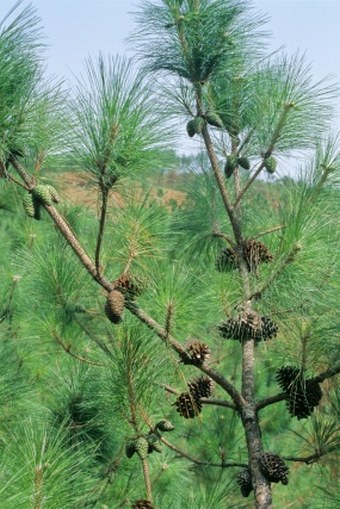
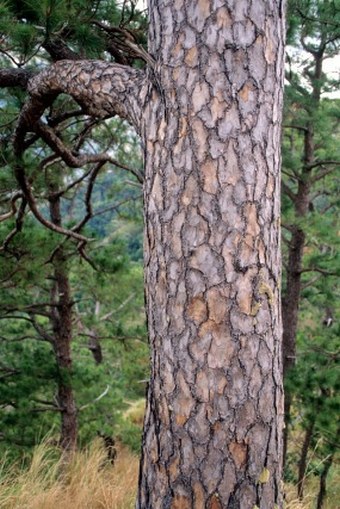
Use: Khasi Pine is one of the most important tropical pine used in forestry around the world. Its plantations can be found in other tropical countries in Asia (Sri Lanka, other states of India, Malaysia), on Pacific Islands (New Guinea, New Caledonia, Fiji, Hawaii), in Australia, in South and Central America (Argentina, Brasil, Venezuela, Puerto Rico), and in many regions of Africa south of Sahara including Madagascar. Except for ecological purposes (afforestation against water erosion or landscape drying) this pine is used as a source of wood material, which is of moderate strength, suitable for various use as light and heavy structural timber, ship and boat building, flooring, furniture, joinery, turnery, etc. The resin content in heartwood is about 10% or slightly higher, the texture is rather coarse and uneven, the specific gravity is about 500 kg/m3. Adult trees are frequently used for extraction of resin which is of excellent quality, perhaps the most valuable of any in the genus.
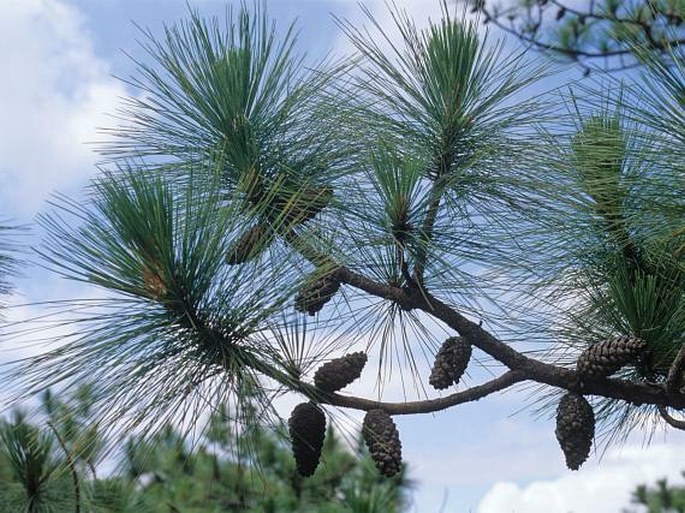

These images were taken in five native populations: Vietnam, Dalat Highlands, Mt. Bi Doup, 1500–2000 m (February 1994); Philippines, Luzon, Zambales Mts., High Peak, 1750 m (March 2000); Luzon, Cordillera Central Mts., 1100–1900 m (March & April 2000); India, Meghalaya, East Khasi Hills Distr., Shillong environs, 1200–1600 m (May 2004); Thailand, Chiang Mai Province, Fang, Ang Khang Mts., 1400–1650 m (May 2009).


